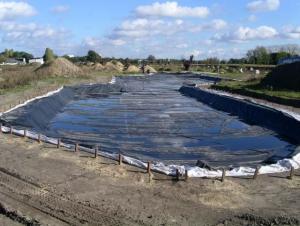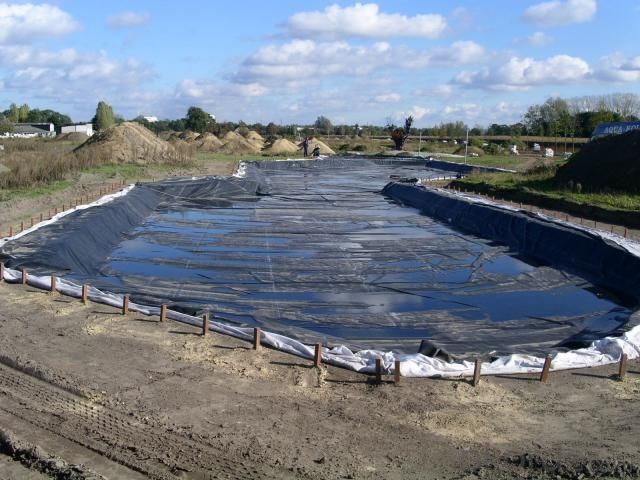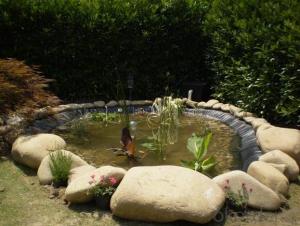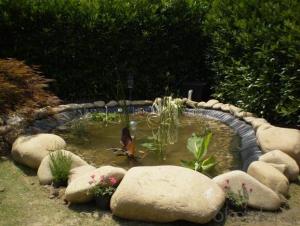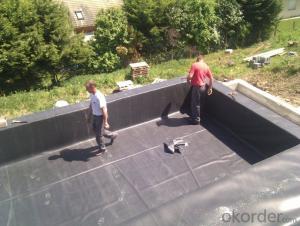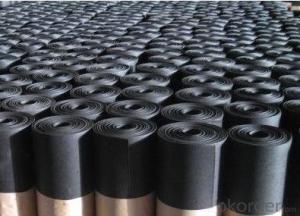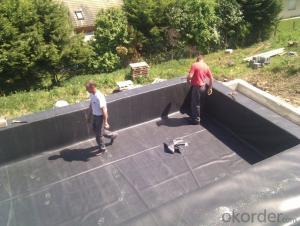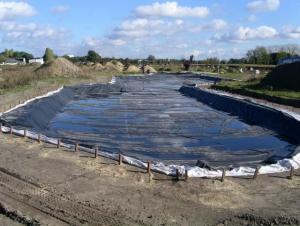EPDM Rubber Waterproof Membrane for Small Pond
- Loading Port:
- Shanghai
- Payment Terms:
- TT OR LC
- Min Order Qty:
- 50000 m²
- Supply Capability:
- 5000000 m²/month
OKorder Service Pledge
OKorder Financial Service
You Might Also Like
EPDM Rubber Waterproof Membrane for Small Pond
Description Of EPDM Rubber Waterproof Membrane for Small Pond:
This waterproof coiled material is of high elasticity with best performance among high polumer waterproof coiled material in the world.It is also the most typical one in the world.Waterproof coiled material made of ternary ethylene-propylene rubber is produced with the use of the most advanced contiuous extrusion and vulcanization technology and related equipments which are specially designed for production of such product.It is good in compactness,without bubble and performance difference in length and breadth,perfomances reach or exceed the demands of GB18173.1-2000 standard.
Main Features of EPDM Rubber Waterproof Membrane for Small Pond:
1.EPDM waterproof membrane for bridge engineering waterproof
2.EPDM waterproof membrane for water conservancy projects ,such as river bank,lake dam seepage.
3.EPDM waterproof membrane for the municipal engineering.
4.EPDM waterproof membrane for aquaculture.
Specifications of EPDM Rubber Waterproof Membrane for Small Pond:
| Number | Item | Unit | Value | |
| 1 | Size Variation | Thichness | % | ±10 |
| Width | % | ±1 | ||
| Length | % | Allowed negative | ||
| 2 | Breaking tensile strength at normal temperature | Mpa | ≥7.5 | |
| Breaking tensile strength at 70°C | Mpa | ≥2.3 | ||
| 3 | Breaking elongation at normal temperature | % | ≥450 | |
| Breaking elongation at -20°C | % | ≥200 | ||
| 4 | Tear strength | KN/m | ≥25 | |
| 5 | Impermeability(30min) | * | 0.3Mpa no leakage | |
| 6 | Bending at low tempreture | °C | ≤-40 | |
| 7 | Stretch tensor at heating | Elongate | mm | ≤2 |
| Shrink | mm | ≤4 | ||
| 8 | Air oven aging(80°C×168h) | Tensile strength at break retained | % | ≥80 |
| Elongation at break retained | % | ≥70 | ||
| 9 | Anti-alkali | Tensile strength at break retained | % | ≥80 |
| Elongation at break retained | % | ≥80 | ||
| 10 | Nuture weathing at manual simulation | Tensile strength at break retained | % | ≥80 |
| Elongation at break retained | % | ≥70 | ||
Applications of EPDM Rubber Waterproof Membrane for Small Pond:
Widely used in roofs, basement, toilet ,swimming pool, and all kinds of industry and civil building waterproofing, reservoir, vivicism, bridge, underground, tunnel and dam waterproofing ,especially to the keystone waterproofing projects which is durability, high corrosion resistance and easy deformation.



IMages of EPDM Rubber Waterproof Membrane for Small Pond:




FAQ of EPDM Rubber Waterproof Membrane for Small Pond:
1. What are we supplying?
We are specialized in producing Colorful Asphalt Roof Shingle, SBS/APP modified bitumen waterproof membrane, Self adhesive bitumen waterproof membrane, PVC waterproofing membrane, EPDM rubber roofing membrane, Single Component Polyurethane Waterproof Coating, and Spray Polyurea Waterproof Coating
.
2. How Many years experience do we have?
We have been exported to more than 20 countries in the past 15 years.
3. How long do we usually reply your request?
We always reply our customer within 24 hours.
- Q: Can a waterproofing membrane be used for bathrooms or showers?
- Bathrooms or showers can benefit greatly from the use of a waterproofing membrane. It is highly advisable to apply this protective layer in order to avoid any water leaks or harm to the underlying structure. Typically, the membrane is spread across the walls and floor of the bathroom or shower area, creating a barrier that stops water from penetrating through. This safeguard not only shields the surrounding areas from moisture, but it also prevents the growth of mold and mildew. Moreover, a waterproofing membrane is instrumental in extending the lifespan of the bathroom or shower by preventing water damage and deterioration. All in all, employing a waterproofing membrane is an efficient solution to ensure the resilience and longevity of these spaces.
- Q: Can a waterproofing membrane be used for bridges?
- Yes, a waterproofing membrane can be used for bridges. Waterproofing membranes are commonly used in bridge construction to protect the bridge deck and structural elements from water penetration and moisture damage. The membrane forms a barrier against water and prevents corrosion of reinforcing steel, extending the lifespan of the bridge.
- Q: Can a waterproofing membrane be used on terracotta surfaces?
- Yes, a waterproofing membrane can be used on terracotta surfaces.
- Q: Are waterproofing membranes suitable for historical buildings?
- Waterproofing membranes can be suitable for historical buildings under certain circumstances. These membranes are designed to protect structures from water damage, which can be particularly important for historical buildings that may have aged and porous materials. However, the suitability of waterproofing membranes for historical buildings depends on various factors. Firstly, it is crucial to consider the specific needs and requirements of the historical building in question. Each building has unique characteristics and materials, and the impact of waterproofing on these elements must be carefully evaluated. Some older structures may have delicate architectural features or materials that could be negatively affected by the application of waterproofing membranes. In such cases, alternative methods that are less intrusive or damaging may be more appropriate. Secondly, it is important to consult with conservation experts or professionals who specialize in historical building preservation. These experts can assess the specific needs of the building and provide guidance on the most suitable waterproofing methods. They can also ensure that any interventions are carried out in a manner that respects the historical integrity and authenticity of the structure. Lastly, it is crucial to consider the long-term implications of waterproofing membranes on historical buildings. While they can provide effective protection against water damage, they may also alter the natural breathability of the building, potentially leading to moisture buildup and further deterioration. Therefore, it is essential to carefully balance the benefits of waterproofing with the potential risks and long-term consequences. In summary, waterproofing membranes can be suitable for historical buildings, but their application should be approached with caution. An assessment of the building's specific needs, consultation with preservation experts, and consideration of long-term implications are critical in determining the appropriateness of waterproofing membranes for historical structures.
- Q: Can a waterproofing membrane be used for swimming pool decks and patios?
- Yes, a waterproofing membrane can be used for swimming pool decks and patios. Waterproofing membranes are designed to create a barrier against water infiltration, making them ideal for protecting these outdoor surfaces from water damage and ensuring their longevity.
- Q: Can a waterproofing membrane be used in bathrooms or showers?
- Certainly, bathrooms or showers can benefit from the use of a waterproofing membrane. In fact, it is strongly advised to incorporate a waterproofing membrane in these spaces to avert water damage and leakage. By serving as a barrier, the waterproofing membrane obstructs water from infiltrating through the walls, floors, and other surfaces in the bathroom or shower. Normally, it is applied prior to tiling or finishing the surfaces, offering an additional shield against moisture and guaranteeing that the underlying structure remains free from dampness. This not only aids in preventing the growth of mold and mildew but also extends the lifespan of the bathroom or shower.
- Q: Can waterproofing membranes be used on plant rooms?
- Yes, waterproofing membranes can be used on plant rooms. Waterproofing membranes are often used in areas where water resistance is necessary, such as basements, roofs, and plant rooms. Plant rooms typically house various mechanical and electrical equipment, and using waterproofing membranes can help protect these sensitive components from water damage.
- Q: Can a waterproofing membrane be installed on metal surfaces?
- A waterproofing membrane is capable of being installed on metal surfaces, indeed. There exist various types of waterproofing membranes to choose from, with some specifically intended for metal substrates. These membranes are typically constructed using materials like PVC, TPO, or EPDM, which possess flexibility and a good adhesive quality to adhere well to metal surfaces. The installation process primarily involves cleaning and preparing the metal surface, and if required, applying a primer. Following this, the waterproofing membrane is applied using adhesive or heat welding techniques. This application creates a protective barrier against water infiltration, thereby preventing corrosion and damage to the metal surface. It is crucial to ensure that the chosen waterproofing membrane is compatible with the specific type of metal in use, and that proper installation procedures are followed to achieve effective waterproofing.
- Q: Can a waterproofing membrane be used on below-grade walls?
- Indeed, a waterproofing membrane is capable of being employed on walls located below ground level. In fact, it is highly advisable to utilize a waterproofing membrane on such walls so as to shield them against infiltration of water and potential harm caused by moisture. Walls situated below ground level are especially susceptible to water penetration due to their proximity to the ground and the possibility of hydrostatic pressure. A waterproofing membrane serves as a protective barrier, effectively preventing water from seeping into the walls and leading to issues such as mold, mildew, decay, and structural impairment. Moreover, it aids in maintaining the interior of the edifice in a dry condition, thereby averting potential problems related to moisture.
- Q: Can a waterproofing membrane be used for crawl spaces?
- Yes, a waterproofing membrane can be used for crawl spaces. Waterproofing membranes are commonly used in crawl spaces to prevent moisture and water infiltration, which can cause structural damage and promote mold growth. By installing a waterproofing membrane, it creates a barrier that keeps moisture out and helps maintain a dry and healthy crawl space environment.
Send your message to us
EPDM Rubber Waterproof Membrane for Small Pond
- Loading Port:
- Shanghai
- Payment Terms:
- TT OR LC
- Min Order Qty:
- 50000 m²
- Supply Capability:
- 5000000 m²/month
OKorder Service Pledge
OKorder Financial Service
Similar products
Hot products
Hot Searches
Related keywords
